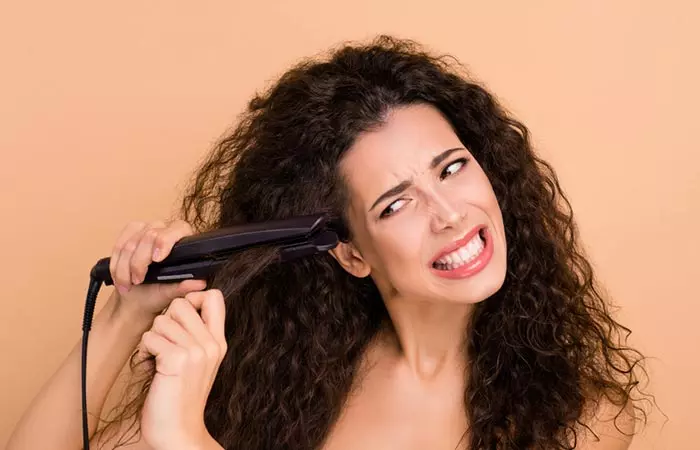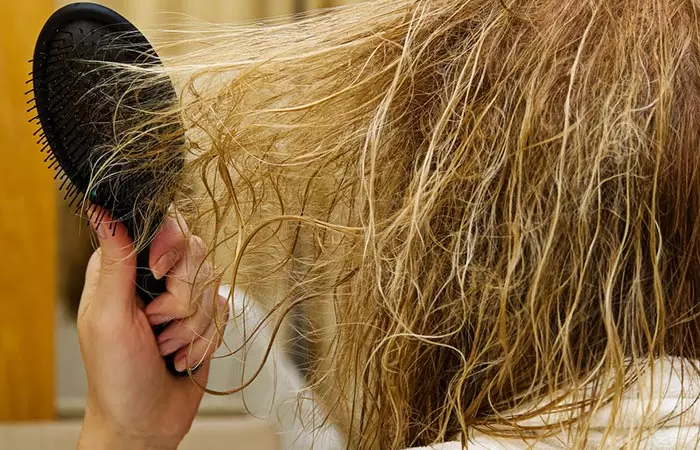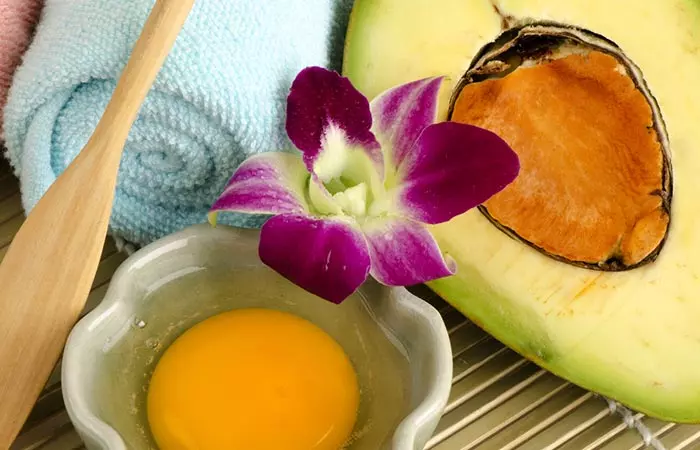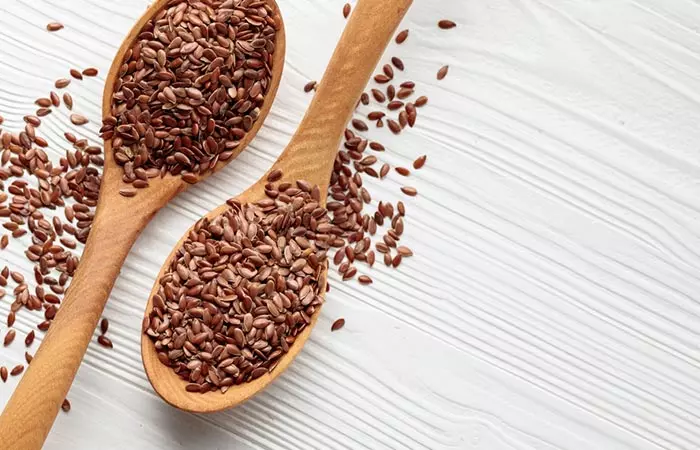The hair shaft has three layers: medulla (the innermost part), cortex (the second layer that contains keratin fibers and melanin), and cuticle (the outer layer composed of dead, overlapping cells). In healthy hair, the cuticles are flat, sealing moisture and protecting the inner layers to keep the hair shiny and smooth. Excessive chemical and color treatments, harsh products and grooming methods, exposure to UV rays, and pollution separate the cuticles, changing the hair texture. As a result, the hair looks frizzy, unmanageable, and damaged and becomes breakage-prone.
What Are The Types Of Hair Damage?
We all dream of having a healthy mane. However, wrong hair care practices and several other factors may damage our hair. Keep scrolling to find out what exactly is responsible for your damaged hair.
What Are The Common Causes Of Hair Damage?
Heat Styling
We all are guilty of using blow dryers, hair straighteners, or curling irons at high temperatures to speed up drying and styling time. The excessive heat can raise the hair cuticles and damage their structure. Regular use of heat styling tools can make the hair dry and brittle. However, this does not mean you have to avoid using heat styling tools altogether. All you need to do is proceed with caution. Follow these tips:
Stress
Physical and psychological stress may cause hair fall (1). Environmental stressors, such as UV rays, humidity, or pollution, can cause hair loss by releasing free radicals. To prevent hair damage: To avoid mental and emotional stress, take help from a therapist, try yoga, meditation, and relaxation techniques. Also, maintain a good daily hair care routine.
Chemicals
Dry, rough, and brittle hair is often an aftermath of excessive chemical processing. Hair dyes, relaxersi Chemical products, like creams or lotions, used to straighten and manage tight curls or curly hair. , and bleaching agents penetrate the cortex (inner part of the hair) and weaken the hair strands, causing damage from within. They make the hair more permeable to other chemicals, such as formaldehyde or ammonia, further damaging the hair shaft and the scalp. You can avoid this by doing the following:
pH Balance
Harsh shampoos, conditioners, and other hair care products disrupt the natural pH balance of your head. Always use products that are specially formulated to balance the pH of your hair and scalp.
Wet Hair
Wet hair is porous and fragile and can be easily damaged. Brushing wet or damp hair can stretch the hair and fracture the shafts.
Tight Hairstyles
Styling your hair the wrong way can contribute to hair damage. Tight hairstyles like buns and ponytails can pull the hair at the roots, causing hair fall and hair breakage. This may also recede your hairline and cause bald spots.
Nutritional Deficiency
Nutritional deficiency may cause hair fall and affect hair quality. Consume foods rich in protein, iron, copper, zinc, essential fatty acids, folic acid, amino acids, and vitamins for hair growth and the maintain healthy hair quality (2).
Fungal Infections
Dandruff is a common fungal infection of the scalp caused by the microbe Malassezia. It feeds on sebum and natural scalp oils and causes irritation and inflammation that may affect hair and scalp health and cause hair loss in the long run. Use anti-dandruff shampoos and consult a doctor for treatment.
Hair Type And Texture
Thin and fine hair is susceptible to damage. Be gentle when grooming your hair and follow a proper hair care routine to keep it healthy.
Bad Hair Care Practices
From taking hot showers to sleeping with damp hair, we put our hair through a lot of stress. These habits can damage your hair. Always avoid Damaged hair is fragile. Hence, it needs more care. A dedicated hair care routine will help you fix it. Here are a few ways you can repair or restore your hair health. A wide range of factors contribute to damaged hair. But how do you know if it is damaged in the first place? Find out in the next section.
How Do You Know If Your Hair Is Damaged?
You can tell if your hair is damaged by looking out for the following signs:
Hair strands break easily Hair is thick at the top but thin towards the ends Frizzy hair Dull or severely dry hair Excessively tangled hair Patches of short hair due to over-bleaching or toning
Rach Wat, a beauty blogger, recounted her struggles with damaged hair. In her blog, she wrote, “Other than the white hair snapping, I began to get really bad split ends, color still doesn’t stay properly in my hair, and the split ends make hair more difficult to style as my hair just doesn’t want to behave (i).” If you notice these signs, it is time to give your hair some TLC. Check out the next section for some simple ways to restore your hair health and vitality.
How Do You Treat Damaged Hair?
Wash your hair twice or thrice a week to keep it clean and free of dead skin cells, dirt, excess sebum, and dandruff. Use glycerin-based shampoos and conditioners. Go for deep conditioning treatments like using a good hair mask once a week. Apply detanglers, serums, and leave-in conditioners. These products offer multiple benefits like oil control, imparting shine, and smoothing the hair. They also protect your hair from damage and tame frizz. Massage your scalp with moisturizing oils once a week. It boosts circulation, stimulates hair growth, and improves hair thickness. Get regular haircuts. This removes split ends and protects your hair from further damage. Avoid products that contain sulfates, parabens, alcohol, synthetic dyes, and fragrances.
You can also try home remedies to keep your hair healthy. Home-made hair masks with simple ingredients are widely used to nourish the hair and keep it hydrated. Check out some popular home remedies in the next section.
Home Remedies For Repairing Dry And Damaged Hair
1. Avocado And Egg Mask
Research shows that the peptidesi Short chains of amino acids (usually 2 to 50) connected by chemical bonds that occur naturally in human tissues. in the egg yolk promote hair growth (3). Avocado is widely used as a home remedy to soften the hair. You Will Need
1 small and ripe avocado 1-2 eggs (depending on your hair length and thickness)
Process
2. Banana And Yogurt Hair Mask
Olive extracts (including oil) can stimulate hair growth (4). Anecdotal evidence claims that bananas and yogurt are excellent hair moisturizers. You Will Need
1 ripe banana 1 tablespoon of olive oil 2-3 tablespoons of yogurt
Process
3. Flaxseed Gel Serum
This is a popular DIY remedy and is said to keep the hair hydrated. You Will Need
2 teaspoons of flaxseed 250 ml of water Muslin cloth
Process
Home remedies are a great option, but for more intensive hair treatment for damaged hair, it is a good idea to visit a salon. Go for special hair treatments (keratin) or hair spas occasionally to pamper and treat your damaged hair professionally. However, if you do not see any progress, consult a doctor.
When To See A Doctor
It is advisable to consult a dermatologist if you notice:
Excessive hair fall Dry, dull hair accompanied by fatigue and weight loss Sudden thinning of hair or discoloration Burning sensation on your scalp Itchiness, redness, or scalp irritation
How long does it take to repair damaged hair? Check out the infographic below to know more! Illustration: StyleCraze Design Team About 6 months to a year. According to anecdotal evidence, using correct hair care techniques and specialized nourishing hair care products may help repair damaged hair effectively. Does damaged hair grow slower? Possibly. Anecdotal evidence indicates that damaged hair, or hair prone to breakage, may grow slowly. What happens if you don’t cut damaged hair? Anecdotal evidence suggests damaged hair, if left uncut, may lead to split ends and fraysi Hair strands that are dry and damaged especially towards the end and prone to split ends due to heat and chemical exposure. and may appear thinner. Will damaged hair grow back healthy? Yes. If you allow your hair to recover without the use of chemicals and heat styling tools and nourish it with the right products and techniques, it will be able to repair itself. Learn how to repair damaged hair with natural remedies. Watch this video to discover simple and effective tips to restore your hair’s health and shine.










